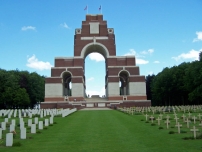| First Name: | Albert Victor | Last Name: | HESSEY | |
|---|---|---|---|---|
| Date of Death: | 15/09/1916 | Lived/Born In: | Queen's Park | |
| Rank: | Rifleman | Unit: | Rifle Brigade9 | |
| Memorial Site: | Thiepval Memorial, France | |||
Current Information:Born-Paddington
The Battle of the Somme (July-November, 1916) By the beginning of September, 1916, the Battle of the Somme had been raging for two months. Thousands of men had already been killed or wounded or were simply missing, never to be seen again and and just a few square miles of the French countryside, all in the southern part of the battlefield, had been captured from the enemy. Mistakes had been made by the various commanders and would be continued to be made but there was no turning back as the British, Australians, South Africans, New Zealanders and Canadians carried on battering away at the German defences in the hope of a breakthrough, So it continued all the way through to November with nearly every battalion and division then in France being drawn into it at some stage. In the end the German trenches had been pushed back a few more miles along most of the line but the cost in lives had been staggering. By the end of the fighting in November, 1916, British Army casualties numbered over 400,000, killed, wounded and missing. The Battle of Flers-Courcelette (15-22 September, 1916) On 15th September, 1916, the offensive on the Somme was renewed with a full scale attack on the German third line of defences. Four Army Corps were used on a front that stretched from Combles, through the village of Flers and on to Courcelette. The artillery barrage that preceded this attack was more concentrated than that on 1st July and the attack itself was more successful. The villages of Flers, Martinpuich and Courcelette were captured and the enemy was finally pushed out of High Wood, but the breakthrough was not achieved and the reality was that when the battle ended on 22nd September, the front line had just been moved forward a mile or so. The battle is notable for being the first time that tanks were used. On 15th September, 14th Division attacked towards the village of Flers from a line to the east and north of Longueval and Delville Wood. 41 Brigade led the advance and after some fierce fighting they captured the first two objectives, the Flers Switch Line and Gap Trench. Following behind came 42 Brigade, advancing at 6.20 am from their assembly positions on rear slopes of Caterpillar Valley. On the right 9th Rifle Brigade, followed by 9th King’s Royal Rifle Corps passed east of Delville Wood, while 5th Shropshire Light Infantry and 5th Oxford & Bucks Light Infantry, passed through the wood. They deployed 400 yards from the Switch Line along the Ginchy-Gueudecourt road but in doing so, 42 Brigade had carried the advance beyond that of the flanking divisions and were therefore subject to enfilade fire from both flanks. At 11.20am 9th Rifle Brigade and 9th King’s Royal Rifle Corps tried to advance across Bulls Road but were stopped by machine-gun fire from Gird Trench. By now the two battalions had been reduced to 350 and being unable to continue the attack, they went to ground and consolidated a line of shell holes position running south-east to Gas Alley. Among the many casualties suffered by 9th Rifle Brigade on this day was Albert Hessey. |
||||
| « Back to Search Results | ||||
| If you think any of the information shown here is incorrect, Click Here to submit your amends and comments | ||||




